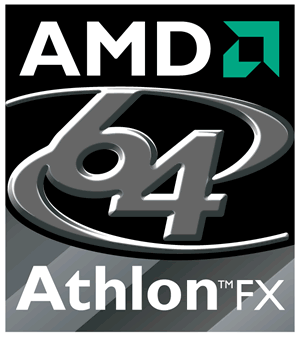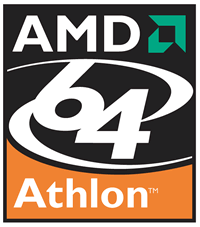Copyright Michael Karbo and ELI Aps., Denmark, Europe.
Chapter 32. Examples of CPU’s
In this chapter I will briefly describe the important CPU’s which have been on the market, starting from the PC’s early childhood and up until today.
One could argue that the obsolete and discontinued models no longer have any practical significance. This is true to some extent; but the old processors form part of the “family tree”, and there are still legacies from their architectures in our modern CPU’s, because the development has been evolutionary. Each new processor extended and built “on top of” an existing architecture.
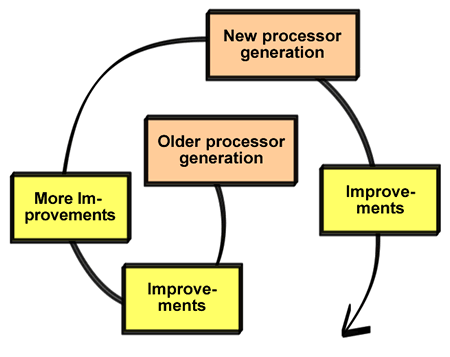
There is therefore value (one way or another) in knowing about the development from one generation of CPU’s to the next. If nothing else, it may give us a feeling for what we can expect from the future.
16 bits – the 8086, 8088 and 80286
The first PC’s were 16-bit machines. This meant that they could basically only work with text. They were tied to DOS, and could normally only manage one program at a time.
But the original 8086 processor was still “too good” to be used in standard office PC’s. The Intel 8088 discount model was therefore introduced, in which the bus between the CPU and RAM was halved in width (to 8 bits), making production of the motherboard much cheaper. 8088 machines typically had 256 KB, 512 KB or 1 MB of RAM. But that was adequate for the programs at the time.
Protected mode paved the way for the change from DOS to Windows, which only came in the 1990’s.

32 bits – the 80386 and 486
The Intel 80386 was the first 32-bit CPU. The 386 has 32-bit long registers and a 32-bit data bus, both internally and externally. But for a traditional DOS based PC, it didn’t bring about any great revolution. A good 286 ran nearly as fast as the first 386’s – under DOS anyway, since it doesn’t exploit the 32-bit architecture.
The 80386SX became the most popular chip – a discount edition of the 386DX. The SX had a 16-bit external data bus (as opposed to the DX’s 32-bit bus), and that made it possible to build cheap PC’s.

The fourth generation
The fourth generation of Intel’s CPU’s was called the 80486. It featured a better implementation of the x86 instructions – which executed faster, in a more RISC-like manner. The 486 was also the first CPU with built-in L1 cache. The result was that the 486 worked roughly twice as fast as its predecessor – for the same clock frequency.
With the 80486 we gained a built-in FPU. Then Intel did a marketing trick of the type we would be better off without. In order to be able to market a cheap edition of the 486, they hit on the idea of disabling the FPU function in some of the chips. These were then sold under the name, 80486SX. It was ridiculous – the processors had a built-in FPU; it had just been switched off in order to be able to segment the market.

But the 486 was a good processor, and it had a long life under DOS, Windows 3.11 and Windows 95. New editions were released with higher clock frequencies, as they hit on the idea of doubling the internal clock frequency in relation to the external (see the discussion later in the guide). These double-clocked processors were given the name, 80486DX2.
A very popular model in this series had an external clock frequency of 33 MHz (in relation to RAM), while working at 66MHz internally. This principle (double-clocking) has been employed in one way or another in all later generations of CPU’s. AMD, IBM, Texas Instruments and Cyrix also produced a number of 80486 compatible CPU’s.
Pentium
In 1993 came the big change to a new architecture. Intel’s Pentium was the first fifth-generation CPU. As with the earlier jumps to the next generation, the first versions weren’t especially fast. This was particularly true of the very first Pentium 60 MHz, which ran on 5 volts. They got burning hot – people said you could fry an egg on them. But the Pentium quickly benefited from new process technology, and by using clock doubling, the clock frequencies soon skyrocketed.
Basically, the major innovation was a superscalar architecture. This meant that the Pentium could process several instructions at the same time (using several pipelines). At the same time, the RAM bus width was increased from 32 to 64 bits.
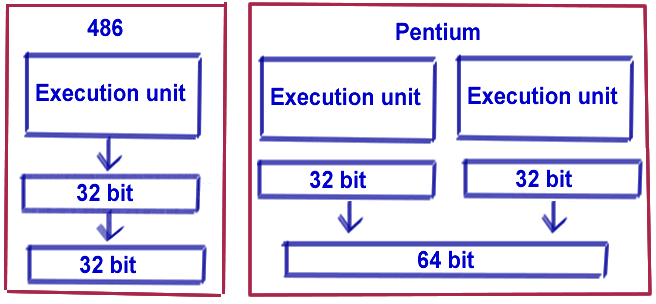
Throughout the 1990’s, AMD gained attention with its K5 and K6 processors, which were basically cheap (and fairly poor) copies of the Pentium. It wasn’t until the K6-2 (which included the very successful 3DNow! extensions), that AMD showed the signs of independence which have since led to excellent processors like the AthlonXP.

Figure 103. One of the earlier AMD processors. Today you’d hesitate to trust it to run a coffee machine…
In 1997, the Pentium MMX followed (with the model name P55), introducing the MMX instructions already mentioned. At the same time, the L1 cache was doubled and the clock frequency was raised.

Pentium II with new cache
After the Pentium came the Pentium II. But Intel had already launched the Pentium Pro in 1995, which was the first CPU in the 6th generation. The Pentium Pro was primarily used in servers, but its architecture was re-used in the popular Pentium II, Celeron and Pentium III models, during 1997-2001.
The Pentium II initially represented a technological step backwards. The Pentium Pro used an integrated L2 cache. That was very advanced at the time, but Intel chose to place the cache outside the actual Pentium II chip, to make production cheaper.
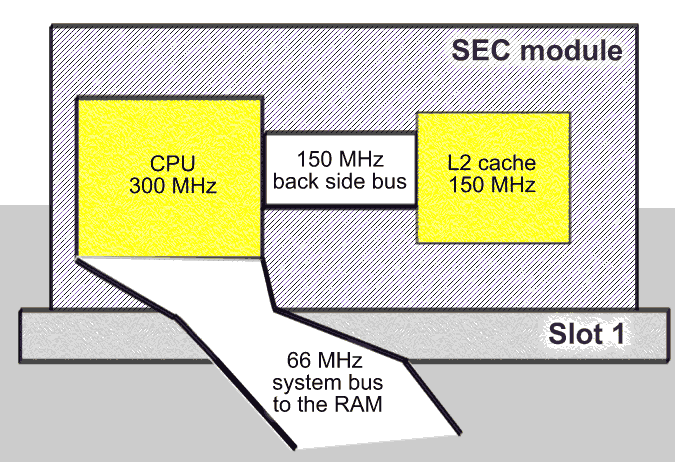
The Level 2 cache was placed beside the CPU on a circuit board, an SEC module (e.g. see Fig. 71). The module was installed in a long Slot 1 socket on the motherboard. Fig. 106 shows the module with a cooling element attached. The CPU is sitting in the middle (under the fan). The L2 cache is in two chips, one on each side of the processor.

The disadvantage of this system was that the L2 cache became markedly slower than it would have been if it was integrated into the CPU. The L2 cache typically ran at half the CPU’s clock frequency. AMD used the same system in their first Athlons. For these the socket was called, Slot A (see Fig. 107).
At some point, Intel decided to launch a discount edition of the Pentium II – the Celeron processor. In the early versions, the L2 cache was simply scrapped from the module. That led to quite poor performance, but provided an opportunity for overclocking.
Overclocking means pushing a CPU to work at a higher frequency than it is designed to work at. It was a very popular sport, especially early on, and the results were good.

One of the problems of overclocking a Pentium II was that the cache chips couldn’t keep up with the high speeds. Since these Celerons didn’t have any L2 cache, they could be seriously overclocked (with the right cooling).

Intel later decided to integrate the L2 cache into the processor. That happened in a new versions of the Celeron in 1998 and a new versions of the Pentium III in 1999. The socket design was also changed so that the processors could be mounted directly on the motherboard, in a socket called socket 370. Similarly, AMD introduced their socket A.
Pentium 4 – long in the pipe
The Pentium III was really just (yet) another edition of the Pentium II, which again was a new version of the Pentium Pro. All three processors built upon the same core architecture (Intel P6).
It wasn’t until the Pentium 4 came along that we got a completely new processor from Intel. The core (P7) had a completely different design:
All of these factors are described elsewhere in the guide. The important thing to understand, is that the Pentium 4 represents a completely new processor architecture.
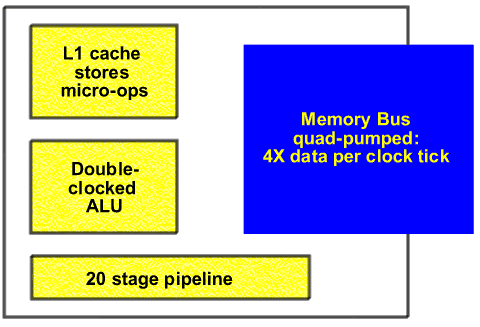
Evolution of the Pentium 4
As was mentioned earlier, the older P6 architecture was released back in 1995. Up to 2002, the Pentium III processors were sold alongside the Pentium 4. That means, in practise, that Intel’s sixth CPU generation has lasted 7 years.
Similarly, we may expect this seventh generation Pentium 4 to dominate the market for a number of years. The processors may still be called Pentium 4, but it comes in al lot varietes.
A mayor modification comes with the version using 0.65 micron process technology. It will open for higher clock frequencies, but there will also be a number of other improvements.
Hyper-Threading Technology is a very exciting structure, which can be briefly outlined as follows: In order to exploit the powerful pipeline in the Pentium 4, it has been permitted to process two threads at the same time. Threads are series of software instructions. Normal processors can only process one thread at a time.
In servers, where several processors are installed in the same motherboard (MP systems), several threads can be processed at the same time. However, this requires that the programs be set up to exploit the MP system, as discussed earlier.
The new thing is that a single Pentium 4 logically can function as if there physically were two processors in the pc. The processor core (with its long pipelines) is simply so powerful that it can, in many cases, act as two processors. It’s a bit like one person being able to carry on two independent telephone conversations at the same time.
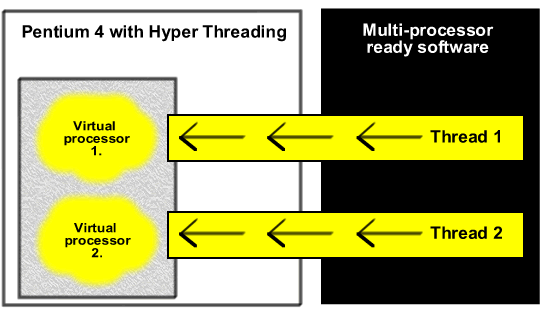
Hyper-Threading works very well in Intel’s Prescott-versions of Pentium 4. You gain performance when you operate more than one task at the time. If you have two programs working simultaneously, both putting heavy pressure on the CPU, you will benefit from this technology. But you need a MP-compatible operating system (like Windows XP Professional) to benefit from it.
The next step in this evolution is the production of dual-core processors. AMD produces Opteron chips which hold two processors in one chip. Intel is working on dual core versions of the Pentium 4 (with the codename ”Smithfield”). These chips will find use in servers and high performance pc’s. A dual core Pentium 4 with Hyper-Threading enabled will in fact operate as a virtual quad-core processor.

Intel also produces EE-versions of the Pentium 4. EE is for Extreme Edition, and these processors are extremely speedy versions carrying 2 MB of L2 cache.
In late 2004 Intel changed the socket design of the Pentium 4. The new processors have no ”pins”; they connect directly to the socket using little contacts in the processor surface.

Athlon
The last processor I will discuss is the popular Athlon and Athlon 64 processor series (or K7 and K8).
It was a big effort on the part of the relatively small manufacturer, AMD, when they challenged the giant Intel with a complete new processor design.
The first models were released in 1999, at a time when Intel was the completely dominant supplier of PC processors. AMD set their sights high – they wanted to make a better processor than the Pentium II, and yet cheaper at the same time. There was a fierce battle between AMD and Intel between 1999 and 2001, and one would have to say that AMD was the victor. They certainly took a large part of the market from Intel.
The original 1999 Athlon was very powerfully equipped with pipelines and computing units:
All in all, the Athlon was in a class above the Pentium II and III in those years. Since Athlon processors were sold at competitive prices, they were incredibly successful. They also launched the Duron line of processors, as the counterpart to Intel’s Celeron, and were just as successful with it.
|
|
Figure 113.
|
Athlon XP versus Pentium 4
The Athlon processor came in various versions. It started as a Slot A module (see Fig. 107 on page 42). It was then moved to Socket A, when the L2 cache was integrated.
In
Later we saw Athlons in other versions. The latest was based on a new kernel called ”Barton”. It was introduced in 2003 with a L2-cachen of 512 KB. AMD tried to sell the 2166 MHz version under the brand 3000+. It did not work. A Pentium 4 running at 3000 MHz had no problems outperforming the Athlon.
Opteron/ Athlon64
AMD’s 8th generation CPU was released in 2003. It is based on a completely new core called Hammer.
A new series of 64-bits processors is called Athlon 64, Athlon 64 FX and Opteron. These CPU’s has a new design in two areas:
Moving the memory controller into the CPU is a great innovation. It gives a much more efficient communication between CPU and RAM (which has to be ECC DDR SDRAM – 72 bit modules with error correction).)
Every time the CPU has to fetch data from normal RAM, it has to first send a request to the chipset’s controller. It has to then wait for the controller to fetch the desired data – and that can take a long time, resulting in wasted clock ticks and reduced CPU efficiency. By building the memory controller directly into the CPU, this waste is reduced. The CPU is given much more direct access to RAM. And that should reduce latency time and increase the effective bandwidth.
The Athlon 64 processors are designed for 64 bits applications. This should be more powerful than the existing 32 bit software. We will probably see plenty of new 64 bit software in the future, since Intel is releasing 64 bit processors compatible with the Athlon 64 series.
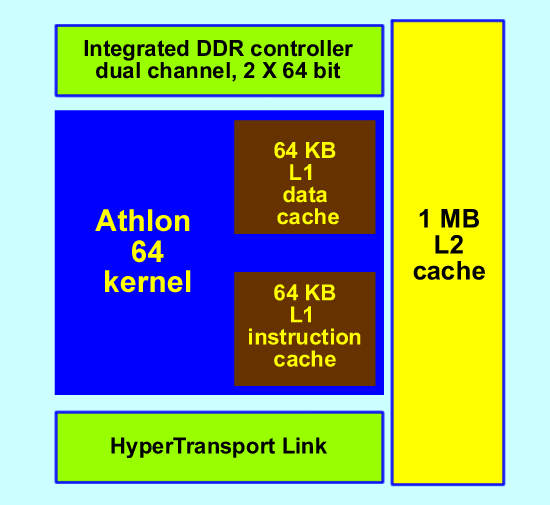
Overall the Athlon 64 is an updated Athlon-processor with integrated north bridge and 64 bits instructions. Other news are:
A complete line of chips
AMD expects to use the K8 kernel in all types of processors:
|
|
The Opteron is the most expensive and advanced version to be used in multi-processor servers. The models are called 200, 400 and 800, and they use 2, 4 or 8 CPUs on the same motherboard – without use of a north bridge. All processors share a common memory of up to 64 GB. Each Opteron has three HyperTransport I/O channels, which each can move 6,4 GB/secund. |
|
|
The Athlon FX is a Opteron to be used in single processor configurations, high-end pc’s and workstations. There is dual RAM interface, but only one channel of Hyper Transport Link. |
|
|
This is the discount version with reduced performance and lower prices. Only 64 bit RAM interface and smaller L2-cache. |
Figure 115. Three versions of the latest AMD processor.
Historical overview
I will close off this review with a graphical summary of a number of different CPU’s from the last 25 years. The division into generations is not always crystal clear, but I have tried to present things in a straightforward and reasonably accurate way:
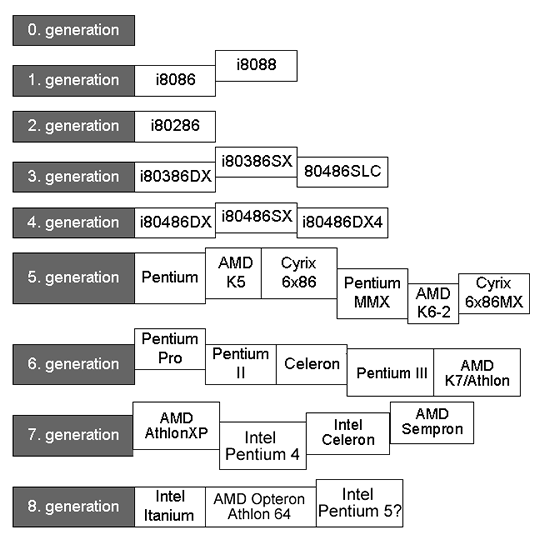
But what is the most powerful CPU in the world? IBM’s Power4 must be a strong contender. It is a monster made up of 8 integrated 64-bit processor cores. It has to be installed in a 5,200 pin socket, uses 500 watts of power (there are 680 million transistors), and connects to a 32 MB L3 cache, which it controls itself. Good night to Pentium.


